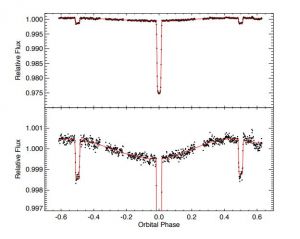“2019年USAAAO决赛第6题”的版本间的差异
Jingsong Guo(讨论 | 贡献) (创建页面,内容为“==英文题目== 6. (15 points) Figure 2 shows a full-phase light curve (“phase curve”) of the exoplanet HD 189733b taken by the Spitzer space telescope. Use…”) |
Jingsong Guo(讨论 | 贡献) |
||
| 第4行: | 第4行: | ||
6. (15 points) | 6. (15 points) | ||
| + | [[文件:USAAAO 2019 Final Fig 2.jpg|缩略图|Figure 2 shows a full-phase light curve (“phase curve”) of the exoplanet HD 189733b taken by the Spitzer space telescope.]] | ||
| − | |||
| − | |||
The star HD 189733 has an effective temperature of 4785 K and a radius of 0.805 Solar radii. | The star HD 189733 has an effective temperature of 4785 K and a radius of 0.805 Solar radii. | ||
2020年3月7日 (六) 17:23的最新版本
英文题目
6. (15 points)
The star HD 189733 has an effective temperature of 4785 K and a radius of 0.805 Solar radii.
a) Use the depth of the planet’s transit to estimate the radius of HD 189733b, in Jupiter radii.
b) Use the depth of the eclipse of the planet by the host star to estimate the ratio of the flux of the planet HD 189733b to that of the host star HD 189733.
c) HD 189733b is so close-in to its host star that it is expected to be tidally locked. Use the phase curve to estimate the ratio of the dayside flux emitted by the planet to the nightside flux emitted by the planet.
d) This phase curve also noticeably has a phase curve offset, that is, the maximum in planet and star flux does not occur exactly at secondary eclipse. What process that occurs in a planetary atmosphere could cause such a phase curve offset?
